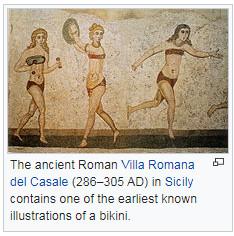 ~
~

While the two-piece swimsuit as a design existed in classical antiquity,[8] the modern design first attracted public notice in Paris on July 5, 1946.[9] French automotive engineer Louis Réard introduced a design he named the "bikini", adopting the name from the Bikini Atollin the Pacific Ocean,[10][11] which was the colonial name the Germans gave to the atoll, transliterated from the Marshallese name for the island, Pikinni.[12]
Four days earlier, the United States had initiated its first peacetime nuclear weapons test at Bikini Atoll as part of Operation Crossroads.[13] Réard hoped his swimsuit's revealing style would create an "explosive commercial and cultural reaction" similar to the explosion at Bikini Atoll.[14][15][16][17]
By making an analogy with words like bilingual and bilateral containing the Latin prefix "bi-" (meaning "two" in Latin), the word bikini was first back-derived as consisting of two parts, [bi + kini] by Rudi Gernreich, who introduced the monokini in 1964.[18][19] Later swimsuit designs like the tankini and trikini further cemented this derivation.[20] Over time the "–kini family" (as dubbed by author William Safire[21]), including the "–ini sisters" (as dubbed by designer Anne Cole[22]), expanded into a variety of swimwear including the monokini (also known as a numokini or unikini), seekini, tankini, camikini, hikini (also hipkini), minikini, face-kini, burkini, and microkini.[23] The Language Report, compiled by lexicographer Susie Dent and published by the Oxford University Press (OUP) in 2003, considers lexicographic inventions like bandeaukini and camkini, two variants of the tankini, important to observe.[24] Although "bikini" was originally a registered trademark of Réard, it has since become genericized.[25]
Variations of the term are used to describe stylistic variations for promotional purposes and industry classifications, including monokini, microkini, tankini, trikini, pubikini, bandeaukini and skirtini. A man's brief swimsuit may also be referred to as a bikini.[2] Similarly, a variety of men's and women's underwear types are described as bikini underwear.
he suit’s creator, Rudi Gernreich, was an Austrian-born American fashion designer and early gay activist who had learned about female fashion in his aunt’s dress shop in Vienna. Rudi and his mother fled Austria after its annexation to Nazi Germany, where Hitler had banned nudity, among many other acts. Austrian citizens were advocates of exercising nude, a rejection of the over-civilized world. Gernreich was very much against sexualization of the human body and the notion that the body was essentially shameful, which was reflected prominently in his designs…
This post was edited by WM BARR . =ABSOLUTE TRASH at May 24, 2019 2:41 PM MDT



 ~
~